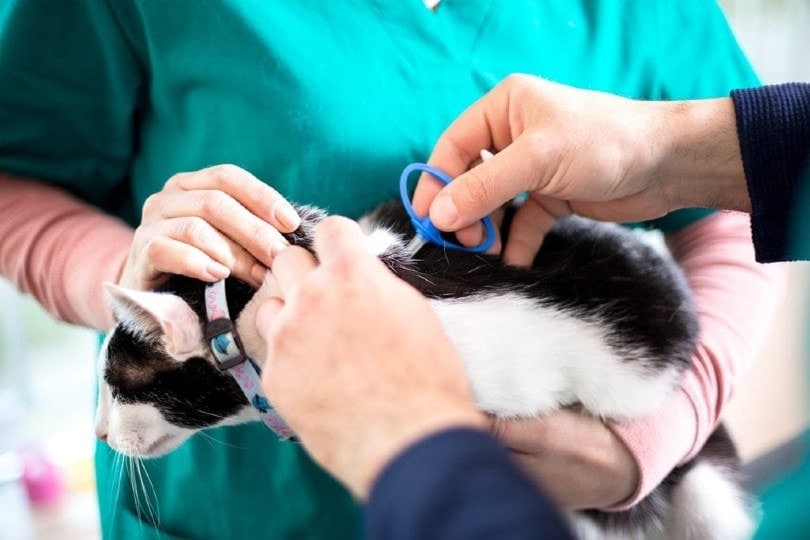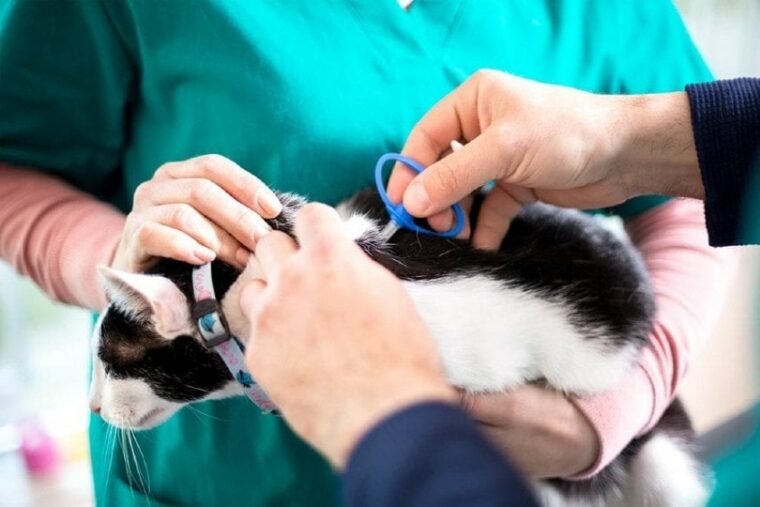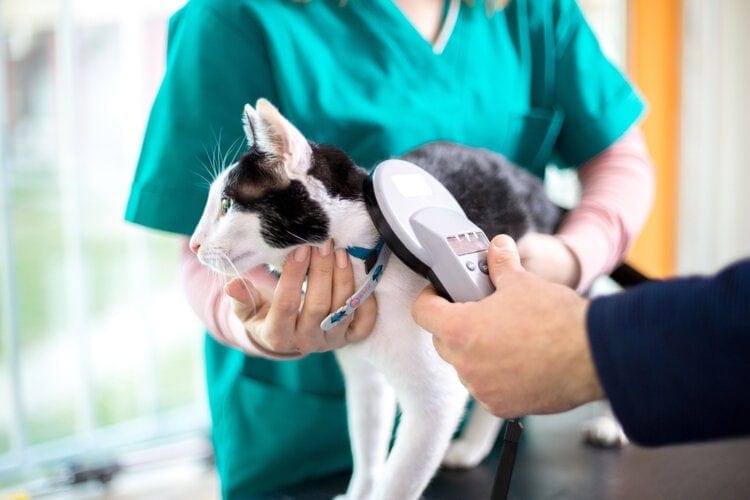- March 30, 2024
How Do Cat Microchips Work? The Fascinating Technology Explained


Cat microchips play an essential role in keeping pets safe. They’re one of the best ways to ensure cats are returned home if they somehow manage to get out and can’t find their way back. Microchips are tiny radio frequency identification (RFID) tags that hold identification numbers linked to owners’ contact information retained in external databases.
They’re passive transmitters, so they only hold information, which can be read using special scanners found in most veterinarians’ offices and shelters. Microchips are implanted in the skin between cats’ shoulders, and the entire process only takes a few seconds from start to finish. Keep reading to learn more about how cat microchips work.
How Does It Work?
Microchips are pretty small; they’re not much larger than rice grains. Devices implanted in cats are encased in biocompatible substances, so they don’t cause reactions in most pets. They’re technically called transponders, and they only flip into action when triggered by electromagnetic waves from scanners. Because cat microchips are passive, they don’t require power sources and don’t have shelf lives 1.
Scanners work as receivers and transmitters. They send radio waves that turn microchips on and power them up to transmit encoded information. A tiny coil or antenna inside the capsule picks up energy transmitted from the scanner, forms a circuit, powers the microchip, and then transmits the information encoded on the chip to the scanner, where the pet’s identification number is received, read, and displayed.
Microchips don’t provide location information or work like GPS or Bluetooth trackers that provide real-time details about pets’ whereabouts. Having a microchip implanted is only one part of the process, and the devices themselves don’t do much unless the owner of the cat has provided the correct registry with their contact information.
Without this important step, connecting the pet’s identification number with the owner’s contact information is impossible. Problems typically emerge because pet parents have either not completed the registration process or have forgotten to provide the registry with updated contact information after a move.
There’s no universal microchip registry in the US; manufacturers have their own systems, and some companies offer fee-based registration services. While it’s possible to register microchips in multiple databases, it’s essential to ensure pet parent contact information is kept up to date with all in which pets are enrolled and to ensure that microchips have been registered with the manufacturer’s registry.

What Are the Different Types of Cat Microchips?
In the US, there are three common microchip frequencies, 125 kHz, 128 kHz, and 134.2 kHz, and the products are available from several manufacturers, but most use the same general technology. Microchips need to be activated by a scanner with a compatible frequency, or they won’t be readable; most shelters and veterinarians in the US now have universal scanners that can communicate with microchips of all three frequencies.
The International Standards Organization (ISO) has identified 134.2 kHz as the go-to universal frequency for pet microchips. The standard ensures that microchips implanted in one country can also be read in other places.
Some, but not all, microchips implanted in the US are ISO-compliant, which can occasionally present challenges for pets traveling to places like the European Union, where ISO-compliant microchips are required for entry.
They’re also the norm in Canada and Japan. Having an ISO-compliant microchip implanted usually solves the problem, and it’s generally not an issue for cats to have two microchips simultaneously as long as they’re running on different frequencies.
Where Is It Used?
Microchip technology for pets is most often used for identification purposes and provides a way to link lost cats with their owners. The technology is almost universally found in shelters and veterinarian’s offices, and many cats adopted from shelters and rescue organizations are sent home with the device already implanted.
RFID technology is used in several industries, primarily to track and gather information. Because passive RFID technology doesn’t require a battery and much space, it can be embedded in products or added to thin items such as cards and stickers.
It’s inexpensive, doesn’t have a shelf life, and is helpful for keeping track of livestock and inventory management. The technology is also used in supply chain management, file tracking, and timing racers.

Advantages of Microchipping
Microchipping has two huge benefits for pet parents: safety and peace of mind. The process is easy and generally well tolerated by cats. It’s an important step that increases the chances that lost pets will be returned home. Being microchipped can often make a massive difference between a cat making it home or not if they get lost and are brought into a shelter.
Disadvantages of Microchipping
There aren’t many disadvantages to microchipping cats; the procedure is fast, easy, and well-tolerated. Most pets do just fine after being microchipped, and even minor side effects such as swelling and tenderness occur relatively infrequently, but sometimes the devices move around a bit.
Infections and a bit of hair loss can also sometimes occur. The system isn’t foolproof, and it only works if owners provide their contact information to the correct registry and keep it updated.

Frequently Asked Questions
Are There Other Ways to Keep Cats Safe?
While microchips are incredibly important, outfitting cats with old-fashioned collars featuring their owners’ contact information can go a long way toward keeping them safe.
Having contact information front and center makes it easy for people to reach out if they find cats wandering about since there’s no need to head to a veterinarian or shelter to find out how to contact the owner. Breakaway collars are the safest options as they disengage and allow cats to escape if caught on something.
Does Getting Microchipped Hurt Cats?
Cats probably experience about as much discomfort when having a microchip implanted as they do when getting a vaccination or having blood drawn.
They generally don’t need anesthesia, but it’s sometimes possible to have kittens microchipped at the same time they’re spayed or neutered, which may make the process easier for some pets to tolerate.
Do Microchips Need to Be Replaced?
Because they don’t actively transmit information or have power sources, most don’t require any sort of regular upkeep or maintenance. Like all mechanical devices, microchips can stop working occasionally, making it critical to take steps to ensure that everything is working properly.
Many veterinarians check to ensure microchips run smoothly and in the right location during regular well-cat visits.
What About Privacy?
Microchips only contain a unique identification number that veterinarians and shelters can use to track down owners’ contact details by getting in touch with the registry that holds the information. Owners’ personal details simply aren’t stored in microchips or available when microchips are scanned.
Conclusion
Microchips are small RFID tags inserted under the skin between cats’ shoulders to serve as a form of identification. They’re passive transponders, and special scanners are required to read the information encoded in them. The devices contain a microchip and an antenna.
The scanner sends electromagnetic radio waves to the transponder, which are picked up and used to power the microchip. The device sends the information on the microchip through an antenna to a scanner, where the data is received and displayed.
Featured Image Credit: Lucky Business, Shutterstock
Tags
What do you think?
Related Articles

New Puppy Checklist: Gear You’ll Need for Your New Dog
Getting a new puppy is really exciting, but before you welcome them home, it’s important to prepare your space for them. Since puppies need a

How Big Do Mini Poodles Get? Vet Reviewed Average Weight & Growth Chart – Dogster
The information is current and up-to-date in accordance with the latest veterinarian research. Learn more » When you buy a Miniature Poodle, you might not

Can Police Dogs Smell Nicotine? Vet Verified Facts & Info – Dogster
The information is current and up-to-date in accordance with the latest veterinarian research. Learn more » While cigarette sales have been declining steadily for decades,

How Old Is 5 in Dog Years? Vet-Approved Guide to Each Size of Dog – Dogster
The information is current and up-to-date in accordance with the latest veterinarian research. Learn more » A common method for calculating a dog’s age is



